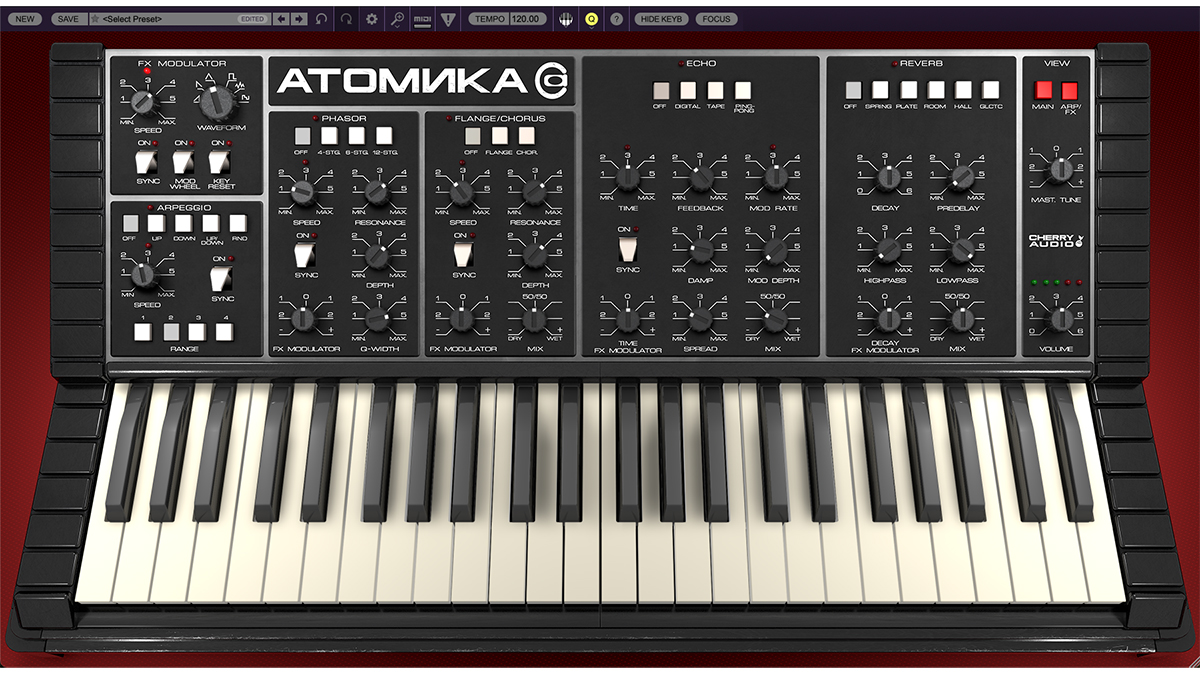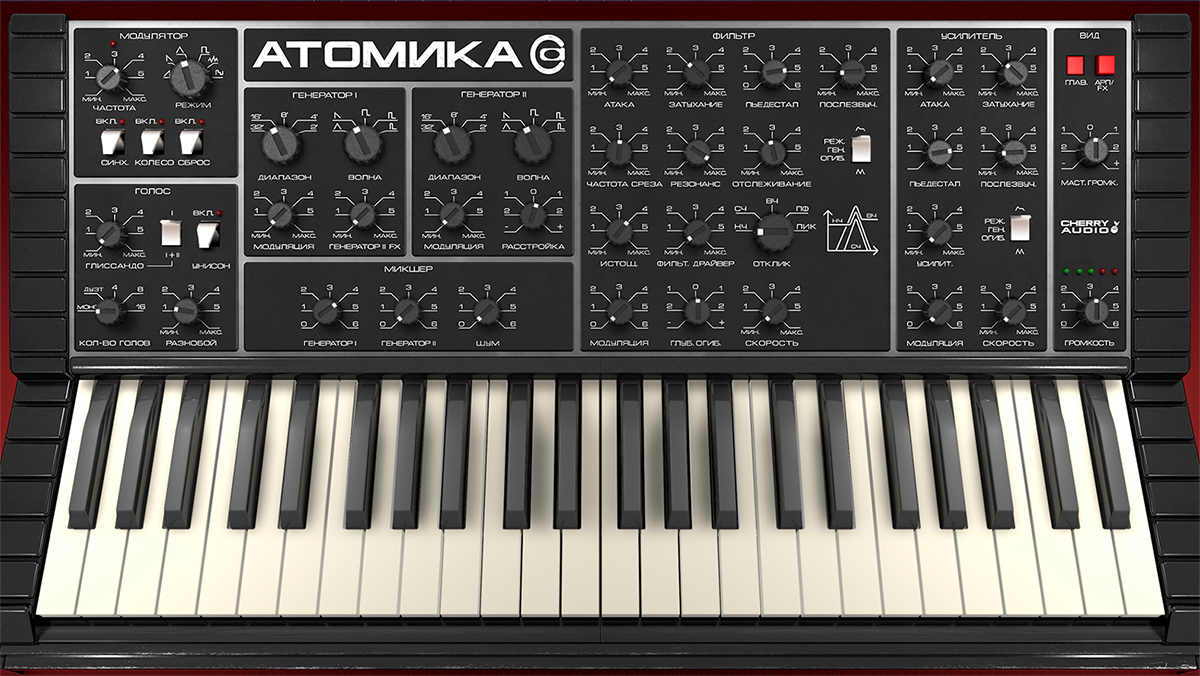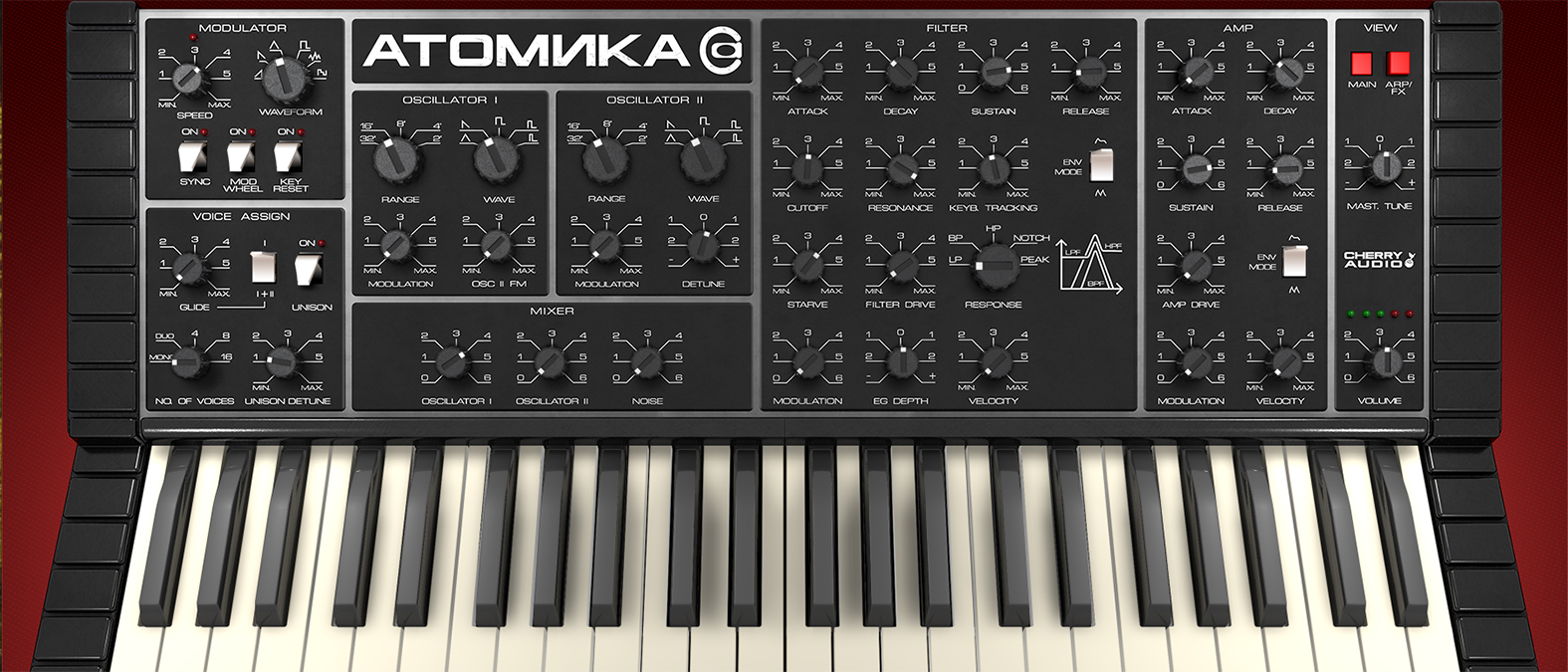MusicRadar Verdict
It could be argued that Atomika pays homage to a misunderstood classic from a bygone age, but you only have to sit down and play with the filter, to understand why it's such a desirable synthesizer for catering to contemporary production requirements.
Pros
- +
Gutsy-sounding synth, in plugin and standalone formats.
- +
The filter could stun you at 20 paces, it’s that gritty!
- +
The modelling and styling is superb.
- +
Onboard effects and a great set of presets.
Cons
- -
Niet!
MusicRadar's got your back
Cherry Audio Atomika: What is it?
Given Russia’s amazing association with the arts, you would have thought that it might have had more success in the electronic instruments domain. Apart from Leon Theremin (a Russian scientist and inventor, who created the Theremin) there have been very few electronic instrument exports, but the Polivoks is easily one of the most recognisable, thanks to its sturdy chassis and front panel, adorned with Russian hieroglyphics.
In fact, many of us who have browsed the pages of a well-known auction website, will undoubtedly have seen the Polivoks, and nervously hovered over the ‘place bid’ button, while not being sure what we are getting into.
This explains why Cherry Audio has grasped the Cold War nettle, and virtually recreated this misunderstood classic analogue synthesizer, providing it with a new identity – Atomika.

Cherry Audio Atomika: Performance and verdict
When the Polivoks was first produced in 1982 (at a cost of 800 rubles), workarounds had to be deployed by the designer Vladimir Kuzmin, to make up for the lack of access to necessary components. It is these workarounds, that have undoubtedly provided much of the character, which makes the Polivoks, and now Atomika, so appealing.
Top of the list is the filter section. Kuzmin employed a workaround to overdrive the op-amps, the result being a particularly aggressive filter, which bears more than a passing resemblance to the likes of the Korg MS series, or TB-303 (when plied with distortion).
Atomika provides an accurate model of this, thanks to the immense perseverance of one of Cherry’s collaborators, Mark Barton. The filter easily gives a trouncing to any preceding signal. On the topic of which, the hierarchy is based around two VCOs, which feed the filter via a mixer. Both of the oscillators provide five of the usual waveforms, and can be blended with white noise at the mixer stage. Like you need anything else in the mix to make the filter scream?
Envelopes, amplifiers and filters
The filter section is equipped with its own dedicated ADSR envelope, which sits alongside the amplifier section, also providing its own envelope parameters. Interestingly, within the amplifier section, we see some backend distortion in the shape of Amp Drive. What's quite curious about this layer of distortion, is that you have to work fairly hard to get it to come alive. Inevitably, this means cranking up the resonance, within the filter section, and riding the cutoff control.
Want all the hottest music and gear news, reviews, deals, features and more, direct to your inbox? Sign up here.
But this is a mere entreé to the overdrive circuit which can be found lurking in the filter section itself. First of all, we must mention that there are five different filter options; low-pass, band-pass, high-pass, notch and peak. These interact in the usual way, with the cutoff and resonance controls, as well as keyboard tracking.
Where the filter becomes more unique, is through the Starve control, which is part of the unique filter design, created by the misuse of the op-amps. The result is a rather characterful, ’bubbly’ sound, as Cherry describes it, and it isn’t wrong! You can hear a warbling creeping in, providing a bizarre additional layer. The success of this parameter is highly dependent upon the other settings that precede it, but it is the filter drive that really brings the party home! When accompanied with the already aggressive resonance, this can really rip your teeth out! It's just what you expect from this style of monosynth, and perfect for those screeching 303-like phrases.
Time to calm it!
With all this talk of aggressive filters, we must address the other side of Atomika’s character. It is actually quite capable of sounding incredibly sweet, while also demonstrating a large degree of depth in the bottom-end frequencies; perfect for bassline duties.
Atomika goes an awful lot further than the original Polivoks, as has already been demonstrated within the filter section, but on a more global level, it has a number of incredibly useful hidden depths.
On the bottom left-hand side of the panel, there are options for creating Unison detuned tones, as well as increasing the voice count to a full 16 notes. One of our favourite facilities was the ability to use Atomika in Duophonic mode. This is where a synth operates monophonically, until you play a second note, at the same time as your first note. The two oscillators are then separated, with each VCO providing the source for each individual note. It's a unique feature, which is quite common on synthesizers such as the Arp Odyssey, but it is fantastic to see it here, in a software recreation.
Effecting arpeggiation
Switching to the effects page, Cherry maintains the characterful fascia, within the realm of the numerous available effects. These include the usual suspects, such as phaser, chorus, echo/delay and reverb. This is also the location where you will find a basic arpeggiator, which operates in a style which is akin to the generation of this machine.

End of the Cold War
Atomika is another stunning recreation from Cherry Audio, with its usual attention to detail. Thanks to its resizeable GUI, you can lock yourself away and get lost in its hidden depths. One cute feature (which you probably won't want to use), allows you to switch all of the legends into Russian. Probably not a great idea, but a neat trick all the same! Cherry has made the interface incredibly inviting and three-dimensional, however it is the character of sound that really drives this plugin, and it will be a brilliant accessory to the more usual polyphonic plugins that are available.
MusicRadar verdict: It could be argued that Atomika pays homage to a misunderstood classic from a bygone age, but you only have to sit down and play with the filter, to understand why it's such a desirable synthesizer for catering to contemporary production requirements.
Cherry Audio Atomika: The web says
"This is another no-brainer instrument from Cherry Audio – and not just because the price is so low, but because it’s hard to imagine any musician not getting a lot of use out of it."
Synth And Software
Cherry Audio Atomika: Hands-on demos
Cherry Audio
CatSynth TV
Folia Soundstudio
Plughugger
Cherry Audio Atomika: Specifications
- KEY FEATURES: 2x VCOS per voice. Switches from monophonic to 16-note polyphony. Duophonic mode is splendid. Aggressive 12dB/oct filter, switchable to five different states. Onboard suite of effects. 350 included presets.
- Mac & PC: AU, VST/3, AAX plugin formats and standalone version.
- CONTACT: Cherry Audio
Roland Schmidt is a professional programmer, sound designer and producer, who has worked in collaboration with a number of successful production teams over the last 25 years. He can also be found delivering regular and key-note lectures on the use of hardware/software synthesisers and production, at various higher educational institutions throughout the UK





